Apple iPhone 4S: Thoroughly Reviewed
by Anand Lal Shimpi & Brian Klug on October 31, 2011 7:45 PM EST- Posted in
- Smartphones
- Apple
- Mobile
- iPhone
- iPhone 4S
Display
Though many expected Apple to redesign everything around a 4“ display, the display on the 4S superficially identical. The 4S includes the same size and resolution display as the 4, namely a 3.54” IPS panel with 960x640 resolution. We’ve been over this a few times already in the context of the iPhone 4 and the CDMA iPhone 4, but it bears going over again.
In retrospect, moving up to 4“ would’ve gone against Apple’s logical approach to maintaining a DPI-agnostic iOS, and it makes sense to spread the cost of changing display resolution across two generations, which is what we see now. While Android is gradually catching up in the DPI department, OEMs on that side of the fence are engaged in a seemingly endless battle over display size. You have to get into Apple’s head and understand that from their point of view, 3.5” has always been the perfect size - there’s a reason it hasn’t changed at all.
I’ve been through a few 4s myself, and alongside the CDMA iPhone 4, have seen the white point of the retina display gradually shift over time. While I don’t have that original device anymore, even now the 4S seems to have shifted slightly compared to a very recently manufactured 4 I had on hand, and appears to have a different color temperature. We’ve been measuring brightness and white point on smartphone displays at a variety of different brightness settings, and the 4S isn’t spared the treatment. I also tossed in my 4 for comparison purposes. The data really speaks for itself.

The first chart shows white point at a number of brightness values set in settings. You can see the iPhone 4 and 4S differ and straddle opposite sides of 6500K. I would bet that Apple has some +/- tolerance value for these displays from 6500K, and the result is what you see here. Thankfully the lines are pretty straight (so it doesn’t change as you vary brightness), but this variance is why you see people noting that one display looks warmer or cooler than the other. I noted this behavior with the CDMA iPhone 4, and suspect that many people still carrying around launch GSM/UMTS iPhone 4 devices will perceive the difference more than those who have had their devices swapped.
The next two charts show display brightness at various settings for solid black and white on the display.
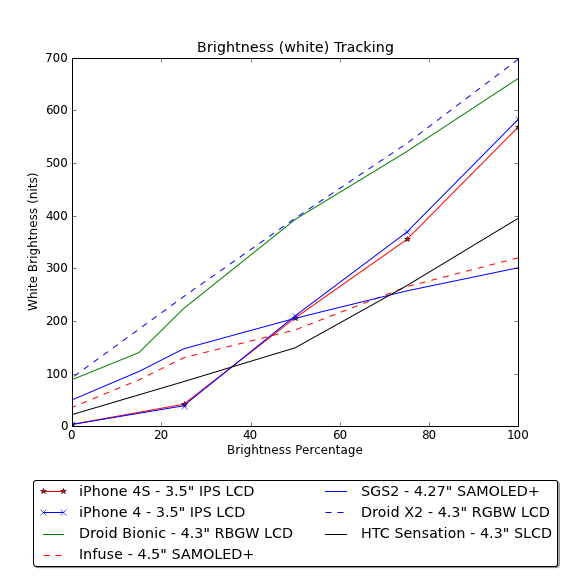
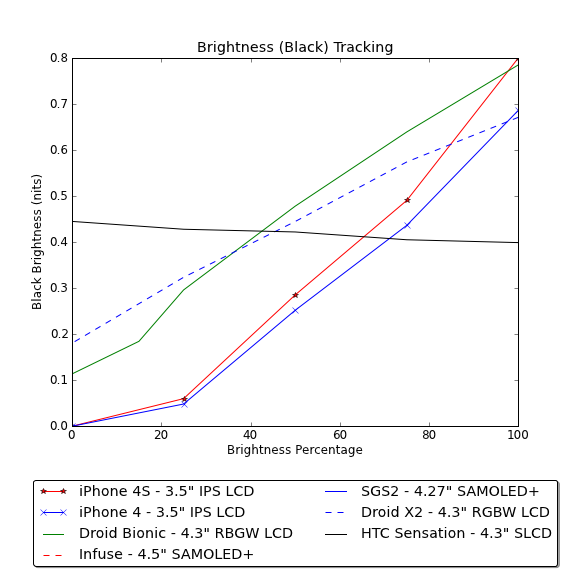
The 4S and 4 displays follow roughly the same curve, however there is a definite shift in contrast resulting from higher black levels on the 4S display. I’ve seen a few anecdotal accounts of the 4S display being less contrasty, and again this is the kind of shift that unfortunately happens over time with displays. I’ve updated our iPhone 4 result on the graph with the latest of a few I’ve been through.
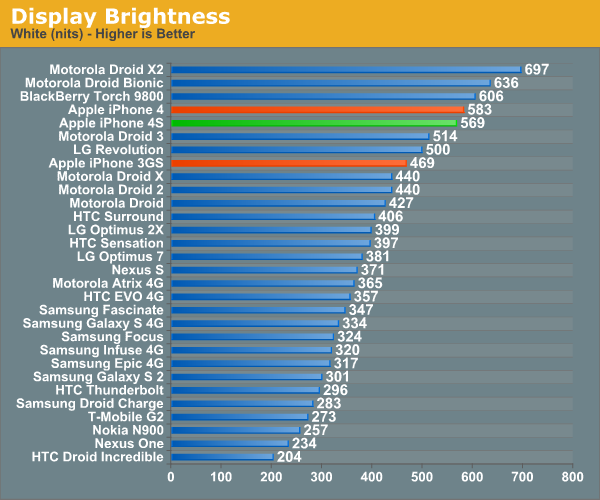
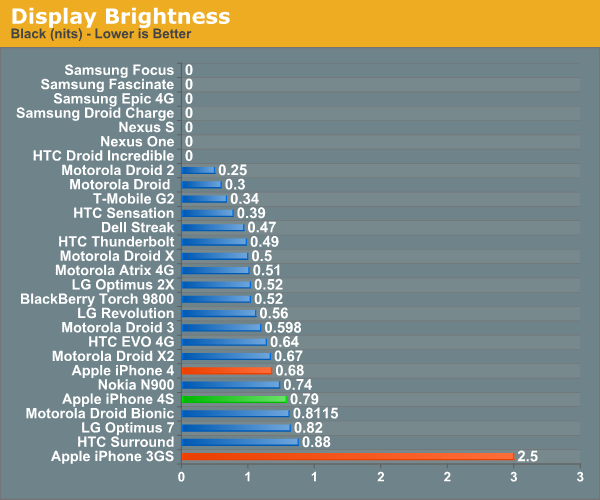
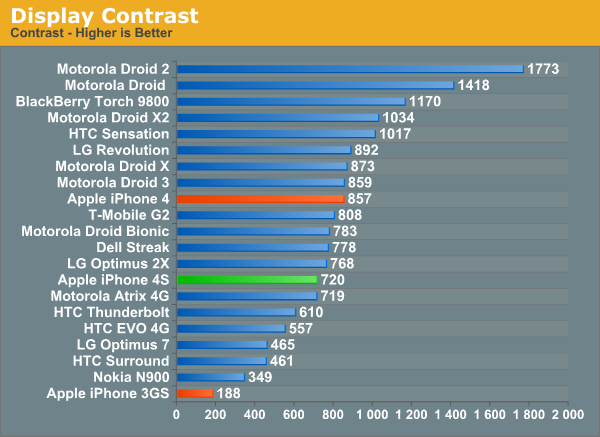
Unfortunately the 4S falls short of the quoted 800:1 contrast ratio, whereas the 4 previously well exceeded it (the earliest 4 we saw had a contrast value of 951). Rumor has it that Apple has approved more panel vendors to make the retina display, I have no doubt that we’re seeing these changes in performance as a result of multiple sourcing.










199 Comments
View All Comments
medi01 - Thursday, November 3, 2011 - link
Find contrast of BEAUTIFUL Galaxy phones on the charts pretty please...doobydoo - Friday, December 2, 2011 - link
Yeah the 'beautiful' screens...The Galaxy screen is what, 480 x 800? on a 4.27 inch screen?
The iPhone 4s is 640 x 960 - on a 3.5 inch screen.
A much higher resolution.
Brian Klug - Sunday, November 6, 2011 - link
"1) Ridiculous BS sentences about "improved vibration" that obviously come straight out of Apple's marketing mouth"I'm sorry you feel that way, but the vibration unit is indeed different, and lends a completely different feel from every other device out there which just uses a spinning counterweight.
I'd encourage you to try it on your own.
-Brian
Samus - Tuesday, November 1, 2011 - link
Great review, thanks Anand! If I weren't so stubborn I'd get an iPhone (because they really are great phones) but I just can't do the Apple thing. I like the openness, tweakability and choices provided by Android phones, but for the general population, the iPhone is pretty much the best option for the high-end market.zanon - Monday, October 31, 2011 - link
Hoorah, the definitive review is here at last! Thanks as always for your hard work on this.And yeah, the 543MP2 is a sick monster of a chip. Imagination Technologies really hit a home run with this one, simply amazing performance. Not just Apple either, I believe the Vita is using the MP4 version of this chip. With the show they've put on this time, I'm very much looking forward to seeing what they do for the Series 6 Rogue ones that I think are still due next year. Or for that matter even if they do an update/shrink of these ones.
Great to see so much competition between graphics in the mobile world, practically every major player has a foot in the water at least. I think this stuff will start to matter more and more too for items beyond games. Applications like further advances in augmented reality seem like they could use plenty of power, and are uniquely suited to mobile platforms. Things will get really nuts when retinal projection displays or some equivalent finally start filtering down into the main market.
Lucian Armasu - Tuesday, November 1, 2011 - link
It's not really about the architecture, though, but about the size of the GPU = more performance. It's 2x the size and has 1.5-2x the performance of Exynos' GPU. Not that surprising.I'm not entirely sure why they had to use such a powerful GPU, though. Is it to make it easier to support higher resolutions? Because it can't be about the games. Why would it get 7x the performance of the previous iPhone 4 GPU, when it can only use 2x of that anyway?
loganin - Tuesday, November 1, 2011 - link
That's a pretty weak and factually wrong claim to discredit Apple's product, not that it's surprising coming from you."Exynos SoC Same Size As Apple A5 In iPad 2"
http://www.itproportal.com/2011/06/07/exynos-soc-s...
zanon - Tuesday, November 1, 2011 - link
loganin already addressed your claptrap regarding size, so we'll just ignore that. A few other bits stand out, however. The first is that, fundamentally, even if you were right so what? You don't win any points for improving in one way vs another, what matters is the result at the end. Regardless of the method PowerVR used the fact that the 543MP2 utterly demolishes the competition, and that it's a beast, would not change.Second, you failed to mention in your "1.5x-2x" the performance bit the fact that it's also clocked *50% slower* then the Exynos. Again, even pretending you were correct, your size difference *still* wouldn't explain the kind of gap we're seeing. Unlike size, which is not perfectly correlated with performance, clock rate pretty directly is. If the 4S's A5 was running at 1.2 GHz, it would be more like 2.8x the performance of the Exynos at the high end.
>>Because it can't be about the games. Why would it get 7x the performance of the previous iPhone 4 GPU, when it can only use 2x of that anyway?
Also, this bit is just WTF. You might have noticed that PC GPUs continue to increase in power? Despite resolutions not continuing to increase? WTF do you mean "you can only use 2x of that"?? At least until the level of complete photorealism with full real time physics modeling of everything is achieved there's always room to spend more power just making the scene look better. Duh.
metafor - Tuesday, November 1, 2011 - link
Erm, GPU clocks are independent of what the CPU is clocked at. I.e. just because the A5's CPU is clocked at 800MHz doesn't mean the GPU is.Apple never really releases what the internal clocks of their various components are running at.
Lucian Armasu - Wednesday, November 2, 2011 - link
Do you even know what 50% slower means? It means half the clock speed. It's not 50% slower. It's 30% slower than Exynos CPU.. It's the Exynos CPU that is "50% faster" than the A5 one.But that's not even what we were talking about. I was talking about the GPU, not the CPU. The GPU has a difference frequency.